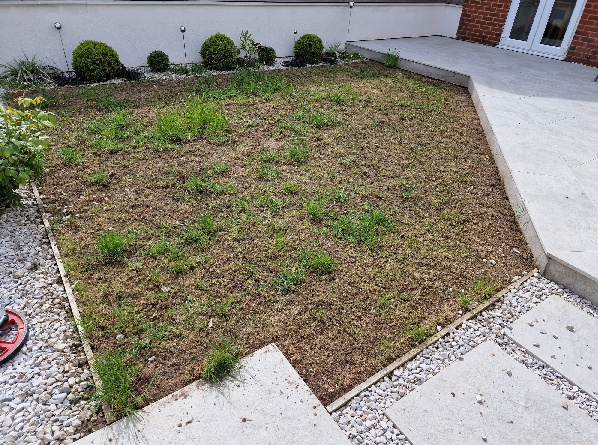
The answer is almost certainly a result of Leather Jacket and bird damage.
Now is the time to take action…
Leatherjackets are the larval stage of the crane fly or daddy long legs, they are about 2.5cm (1″ long), greyish black in colour, legless and with no distinct head. The larvae of some crane flies can damage lawns, small plants in garden borders and vegetable plots by eating roots.
Birds such as crows, magpies, rooks and starlings will search for leatherjackets in turf. These birds leave small round holes in the turf where they have inserted their beaks.
Preventative care will avoid this….




Why ACT NOW?
Why? simply when the young leatherjackets are active in the soil, this is when they are most susceptible to the nematode attack, their natural predator.
Leather Jackets are also known as:
Tipula paludosa (European crane fly)
producing one generation per year, adults emerge from pupation from July to September
Tipula oleracea (Marsh Crane Fly)
producing two generations per year, adults emerge from pupation from April to May and July to September
FAQ’s
Can I check if I have Leather Jacket?
Yes, a simple test can be completed
- Irrigate the area affected
- Peg down a black bag, a bin bag would be ideal for this and leave overnight
- Check for any grubs the following day. If leatherjackets are the problem, grubs should be found on the lawn surface under the cover.
Another indicator for leather jacket activity is that you normally see signs first start at the lawn edge they then work inward, plus you may find discarded casing on the lawn, a clear sign of Leather Jacket activity.
When you start to see the adult Crane Fly (aka daddylong legs) in your garden, normally towards the end of August you will know that in a few days they will be laying eggs. These will hatch quickly; therefore aim to apply two weeks after you see the adults.

Other lawn grubs are Chafer Grub, normally found in sandy soils and caterpillers. These are often found in the sward as birds are hunting these too. They can be mistaken for a chafer grub because they can be white with orange head, they are often much smaller and don’t have the bigger legs at the front of their body.
What happens to my grass?
Lawns develop patches where the grasses turns yellowish brown and often dies. This can be distinguished from similar effects caused by lawn diseases or adverse growing conditions by lifting the affected turf and finding leatherjackets in the surface layers of the soil.
What is the life cycle of leather jackets?

How do I control Letherjacket larvae?
Option 1 – 70% Natural control
Use Nemasys Leatherjacket Killer to deal with the infestation. Its 100% natural incredibly effective and 100% safe for children, cats, dogs, other pets and wildlife.
Option 2 – 99% Combination control
We apply both the natural nematode predator of the grub and a new chemistry insecticide. In development for over 20 years, it’s now available for use by registered lawn care professional. It works by causing paralysis and death of the small grub. Together they make a great combination.
When can I apply Leatherjacket Killer Nematodes?
Autumn application (use single rate) typically late August through to the end of October, the best time is late September and Early October
Spring application (use double rate) typically early April to the end of May.
When can I apply Leatherjacket Combination control?
Autumn application (use single rate) typically late August through to the end of October, the best time is late September and Early October
By law, this product can only be used once per year, so we will only apply the insecticide during this window where is it going to gain the best return on investment.
Where can I buy Nemasys Leatherjacket Killer?
Normally only available from on line retailers, suggestions include:
Greener Gardens link to Nemasys Leather Jacket Control
Green Gardener link to Nemasys Leather Jacket Control
About Aceleprn
New Professional Leatherjacket Control – Acelepryn
Choosing Acelepryn will not be for everyone, It has been in development for 20 years and is a very expensive small bottle!. Please read below
How it is works
The mode of action:
Phase 1 – contact or ingestion of active ingredient
Phase 2 – Active Ingredient binds to and activate the receptors located in insect’s muscle causing them to remain open.
Phase 3 – Calcium flows out of the receptor, causing an uncontrolled release of calcium affecting the muscle. This results in paralysis and death of insect.
This new active ingredient gives professional users a new tool when used with Nematodes as an integrated approach excellent results
• Acelepryn takes 2-3 weeks to reach its optimum control in the soil
• Concentrates in the top 5cm of soil, the grub zone, for optimum control
• Once in this grub zone will give 2 months protection
• Return the clippings for 3 weeks after application
Acelepryn – Pre and Aftercare
• The product must reach the soil. This may require prior scarification for the best results if your lawn has a thatch layer. This could be from ourselves within one of our mechanical calls, or completed by yourself.
• Cut the lawn prior to application
• Water the lawn well both before and following application
• Mulch the clippings (cut with the box off) for the next two weeks. Any of the product that isn’t already washed into the soil will be coated on the grass leaves. We don’t want to remove these – the leatherjackets will feed on these clippings. With this in mind, you may need to increase your mowing frequency to keep the lawn tidy.
More information about lawn grubs here